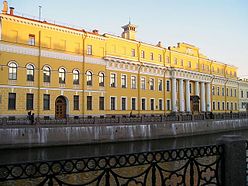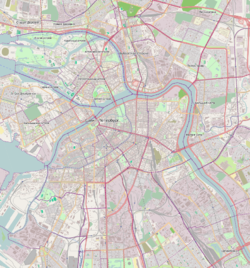- Moika Palace
-
Moika Palace Дворец Юсуповых на Мойке 
The Yusupov Palace from across the Moika RiverGeneral information Town or city St. Petersburg Country Russia Coordinates 59°55′46.2″N 30°17′55.32″E / 59.9295°N 30.2987°E Completed 1770 The Moika Palace or Yusupov Palace (Russian: Дворец Юсуповых на Мойке, literally the Palace of the Yusupovs on the Moika) was once the primary residence in St. Petersburg, Russia of the House of Yusupov. The building was the site of Grigori Rasputin's murder in 1916.[1]
The palace was first built around 1770 by the French architect Jean-Baptiste Vallin de la Mothe. Over the years numerous well-known architects worked on the palace, and it is known for the hodgepodge of architectural styles.
From 1830 to 1917, the palace belonged to the House of Yusupov, an immensely wealthy family of Russian nobles, known for their philanthropy and art collections. Thus in the time of Imperial Russia, the palace became known as the Yusupov Palace.
The palace is most famous, however, because of the actions of its last prince Felix Yusupov. The exact events surrounding Rasputin's death are much in dispute. The story, according to Yusupov, is that on the night of December 16, 1916 he, along with Grand Duke Dmitri Pavlovich of the House of Romanov, invited Grigori Rasputin to the Moika Palace. Supposedly, they served Rasputin cakes and red wine laced with cyanide—supposedly enough poison to kill five men. Concerned that Rasputin appeared unaffected, Yusupov retrieved a gun and shot Rasputin in the back. Taking him for dead, the party prepared to leave. Yusupov returned a short while later to find Rasputin still alive. He and his conspirators shot Rasputin, at close range, three more times, but Rasputin was still attempting to stand back up and flee. Desperate they clubbed Rasputin in the head repeatedly with an iron bar, wrapped him in a blanket, walked outside and tossed him into the Moika River. His autopsy supposedly found that neither the poison, nor the multiple gunshot wounds, nor the clubbing caused his death—instead he died of hypothermia. Much of the account, from Yusupov, is considered implausible.
The Russian Revolution followed shortly after Rasputin's death and once the Soviets came to power, they confiscated the property of the nobles. In 1925, the palace was handed over to the city's Education Commissariat. While most nobles' palaces were converted to mundane use, the Education Commissariat decided to preserve the mansion as a public museum. Today the palace serves as a Palace of Culture for Educators and it also functions as a museum to Rasputin's murder.[2][3] The courtyard where Rasputin attempted to flee from his killers is now occupied by a kindergarten playground adjacent to the palace.
See also
- Yusupov Palace (Crimea)
References
- ^ "Yusupov Palace". The New York Times. http://travel.nytimes.com/travel/guides/europe/russia/st-petersburg/attraction-detail.html?vid=1154659352328. Retrieved on June 10, 2008.
- ^ "Yusupov Palace". Museum's official site. http://yusupov-palace.ru/index_en.htm. Retrieved on June 6, 2008.
- ^ "Yusupov Palace". Fodor's. http://www.fodors.com/world/europe/russia/st-petersburg/review-132741.html. Retrieved on June 11, 2008
External links
- This article incorporates information from the revision as of June 6, 2008 of the equivalent article on the Russian Wikipedia.
Categories:- 1770 architecture
- Palaces in Saint Petersburg
- Saint Petersburg culture
- Visitor attractions in Saint Petersburg
Wikimedia Foundation. 2010.


